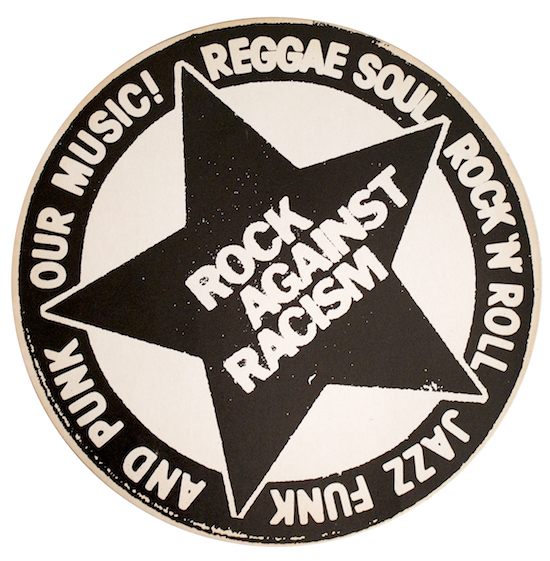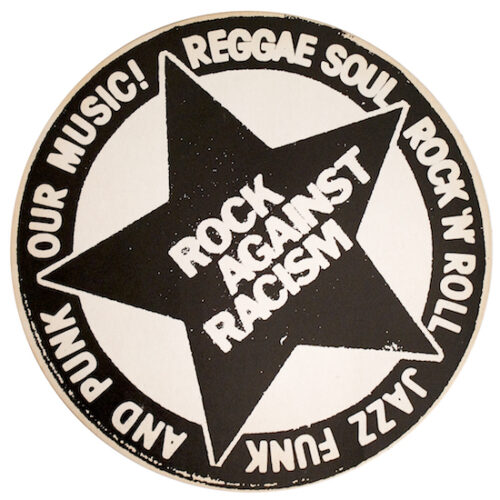There’s a special place in Marxist heaven reserved for Red Saunders, the founder of Rock Against Racism. His campaign was launched in summer 1976 in response to an Eric Clapton gig in Birmingham and the drunken, rambling incoherent speech Clapton gave in support Enoch Powell. “Rock was and still can be,” Saunders wrote, in a letter published in NME and Melody Maker, “a real progressive culture, not a package mail-order stick-on nightmare of mediocre garbage … PS Who Shot the Sheriff, Eric? It sure as hell wasn’t you!”
Over the next six years, RAR organised 500 gigs and 13 Carnivals, they toured over 2000 miles and brought 100,000 people onto the streets twice in huge, free, anti-racist Carnivals featuring some of the sharpest bands of the day: the Clash, Elvis Costello, X-Ray Spex, Steel Pulse and Aswad.
The politics of Rock Against Racism were developed in an article written by East End doctor Dave Widgery and published in the first issue of the RAR fanzine, Temporary Hoarding: “Racism is as British as Biggles and baked beans … Racism is about Jubilee mugs and Rule Britannia and how we won the war. The problem is not just the new fascists [who] form [from] the old slime … the bigger danger is the racist magistrates with their cold sneering authority, the immigration men who mock an Asian mother as she gives birth to a dead child on their office floor.”
RAR is often portrayed as a learning moment; when the idea of institutional racism, which had been developed by generations of black radicals, was grasped for the first time by the white left and then taken up by designers and musicians, throwing the state racism identified by Widgery onto the defensive. That happened; it’s part of our shared history, but it’s not the whole story.
Britain did not open itself to immigration after 1979, in fact the rules got tougher under Thatcher and Blair. Instead of deporting 200-250 people a year, as we did in the 1970s, last year we deported more than 10,000 people.
Nor did Britain stop telling itself in 1979 that the Second World War had been this country’s finest hour and the rest of the world owes Britain forever and should be grateful for our empire.
When people talk about punk as a movement which was open to racism, they might think of something like the Sex Pistols anthem ‘God Save The Queen’ and the repeated nihilism of its final section: “No future, no future, no future for you.” Compare that to the 1970s chant, “What have we got? Fuck all. National Front.”
Or they might recall the swastikas worn by such punk aristocracy as Siouxsie Sioux, Soo Cat Woman or Steve Jones of the Sex Pistols who was photographed beside Jimmy Pursey (a proud participant in both RAR Carnivals) wearing a swastika T-shirt. “I’m not a racist and never have been,” Jones later wrote, “it was a just a way of summoning up the darkness I felt.”
Even if it takes the form of Pepe The Frog memes rather than metal badges, that darkness is still very much part of popular culture. That’s why Brenton Tarrant paused midway through the Christchurch killings to tell his viewers, “Remember lads, subscribe to PewDiePie.”
If you wanted to date the moment when the far right grasped the need for its own cultural turn, there is no better place to start than in April 1978 at the first, great, Rock Against Racism Carnival and among the members of the National Front drowning their sorrows as the huge anti-racist march went past.
Joe Pearce, the leader of the Young National Front, was among them and confides in his memoir his admiration of the “huge size of this anti-racist demonstration” which “illustrated the power of rock music to lure tens of thousands of youngsters to active participation in the political struggle.” When you read this part of his account, Pearce is so effusive that you might think he was acknowledging the errors of his politics and going over to the left. But that wasn’t his point at all.
Pearce’s older brother Stevo was a well-connected young punk who would go on to set up the legendary Some Bizzare label, releasing albums by Soft Cell, The The, Einstürzende Neubauten, Coil, Psychic TV and others.
From spring 1978 onwards Joe Pearce was determined to emulate his brother, and indeed to copy the musical success of the left. He founded Rock Against Communism to “fight back against the left-wingers and anti-British traitors in the music press.” RAC bands included such acts as Damaged, White Boss, Phase One, and (RAC’s highest-profile recruit) Skrewdriver, later the dominant force in the 1980s and 1990s international White Power scene.
All sorts of egalitarian dynamics can be traced back to the RAR launch letter: Joe Strummer’s evolution from Ramones fanboy to White Man in Hammersmith Palais, the two-tone music of the Specials, the National Front’s defeat in the 1979 election. But if you look back at the 1970s from where we are 2019, that anti-racist victory doesn’t feel like the cataclysmic end that RAR’s upbeat supporters hoped they were living through, so much as a mere turning point within the much longer story of the fight to create a world worth living in.
At best, a breathing space.
These days, the sister parties of the old National Front don’t just stand in elections; in Italy and Austria they’re winning them.
When he launched Rock Against Racism, Saunders called for “a rank and file movement against the racist poison in rock music.” Swap popular culture for rock music, and the need for that movement is greater than it has ever been.



